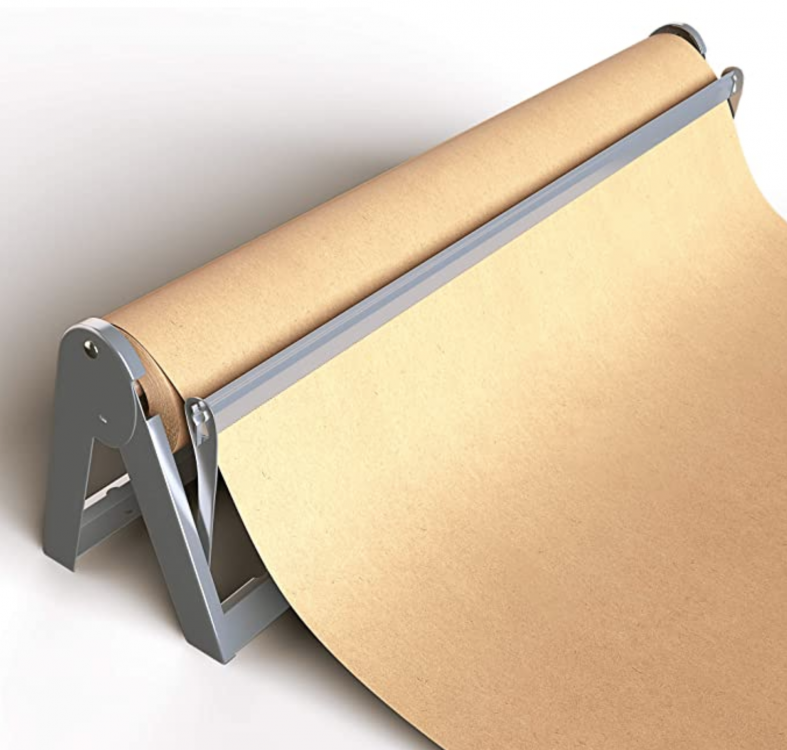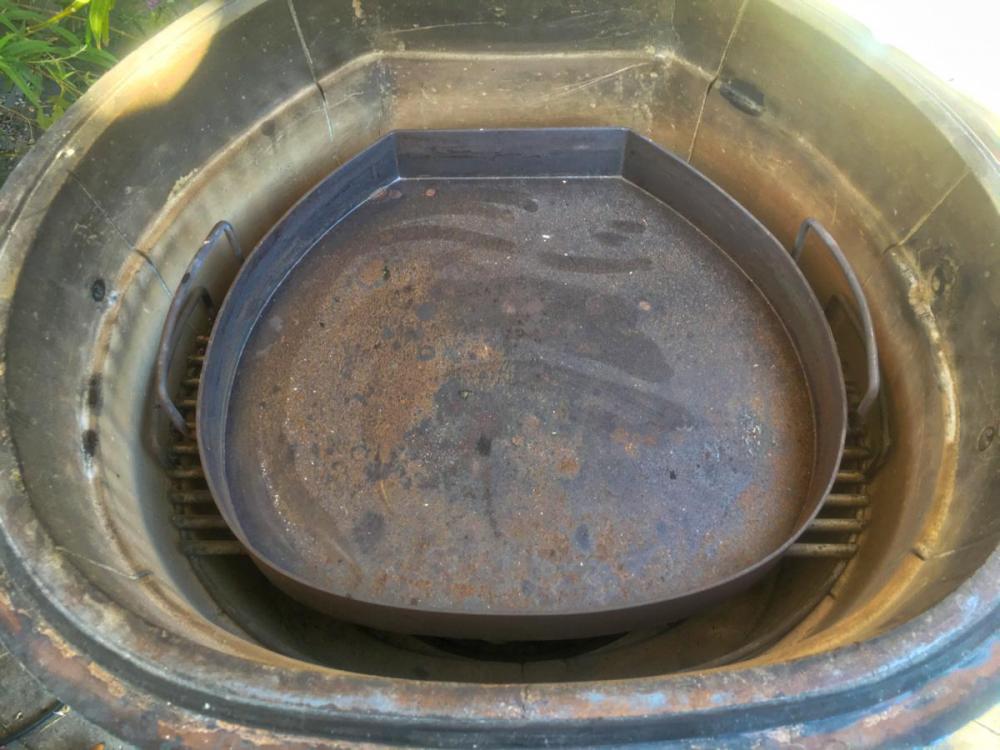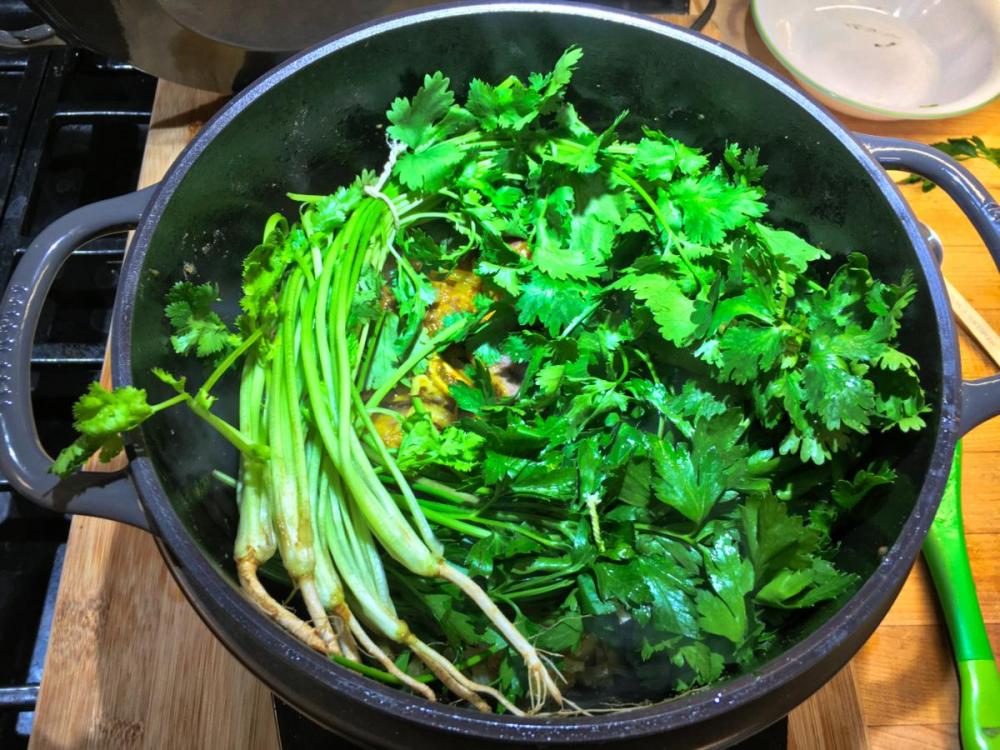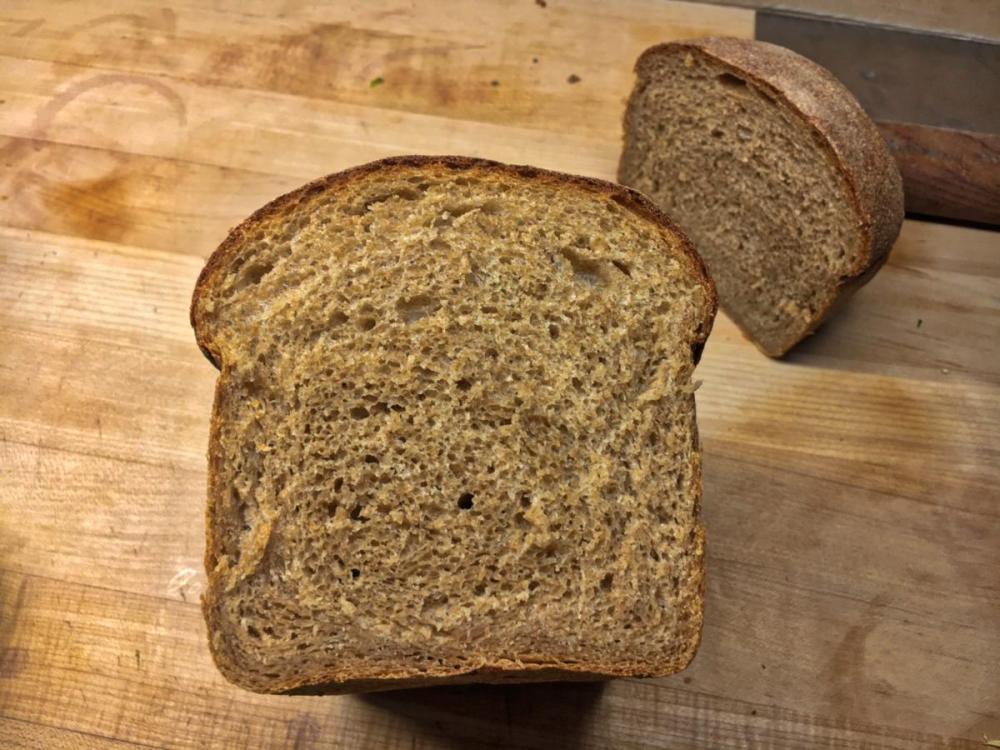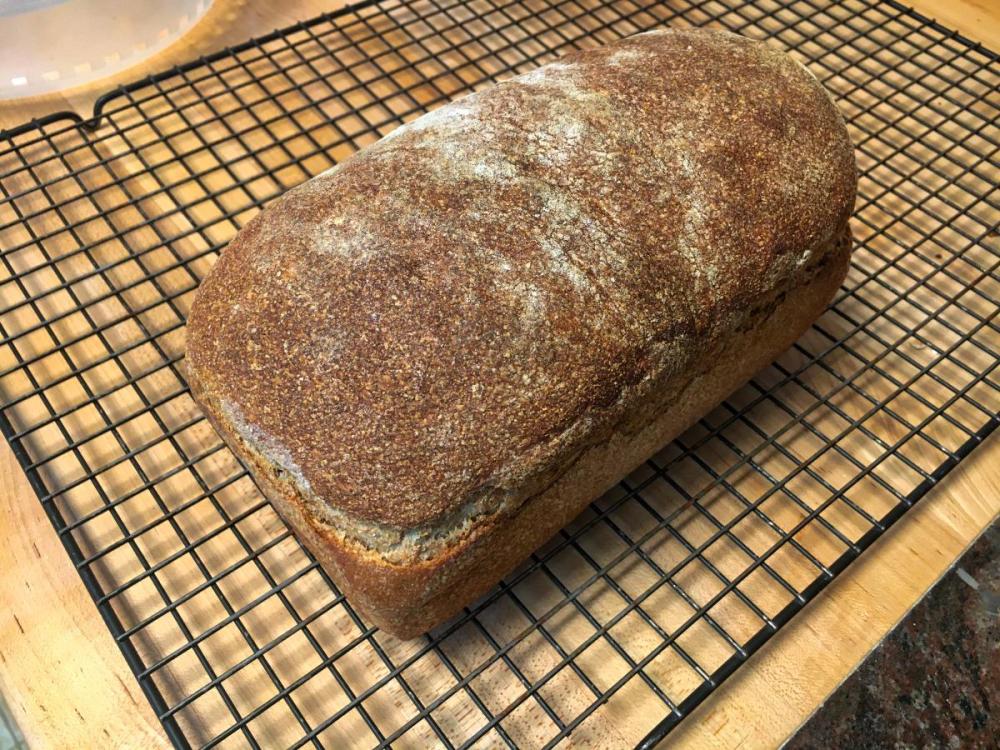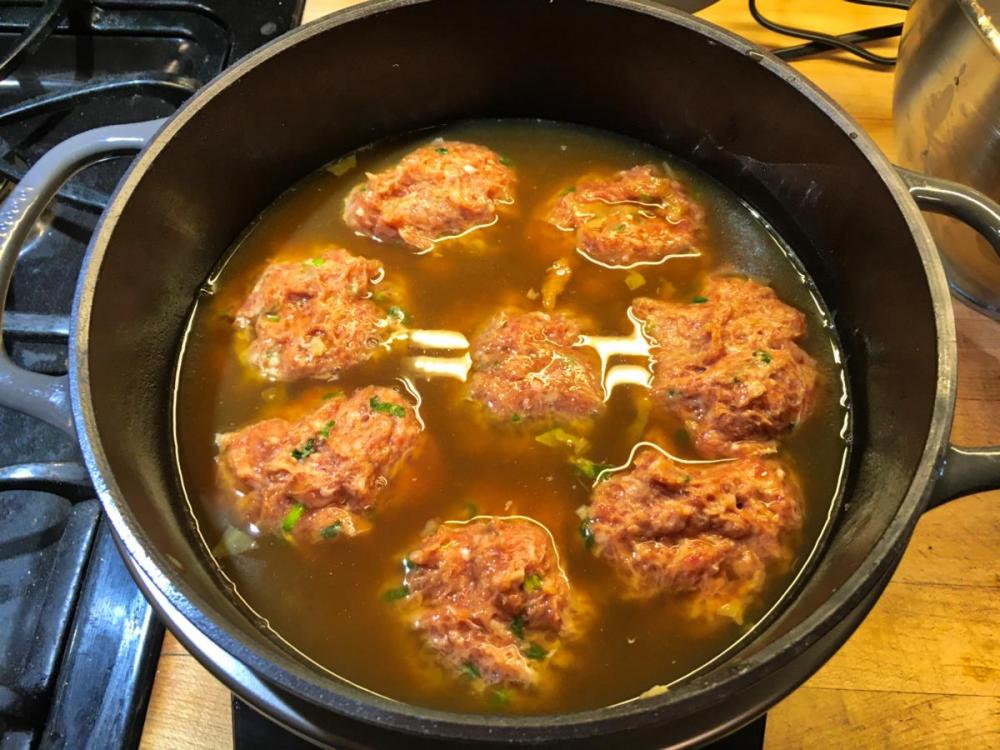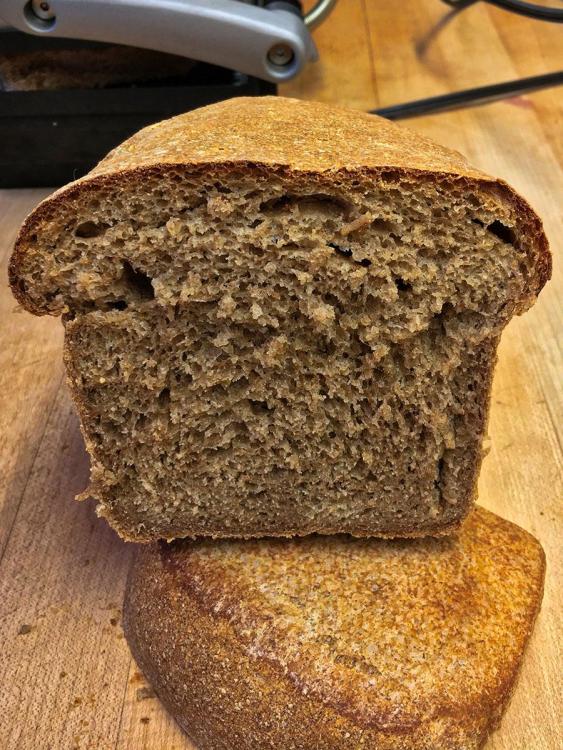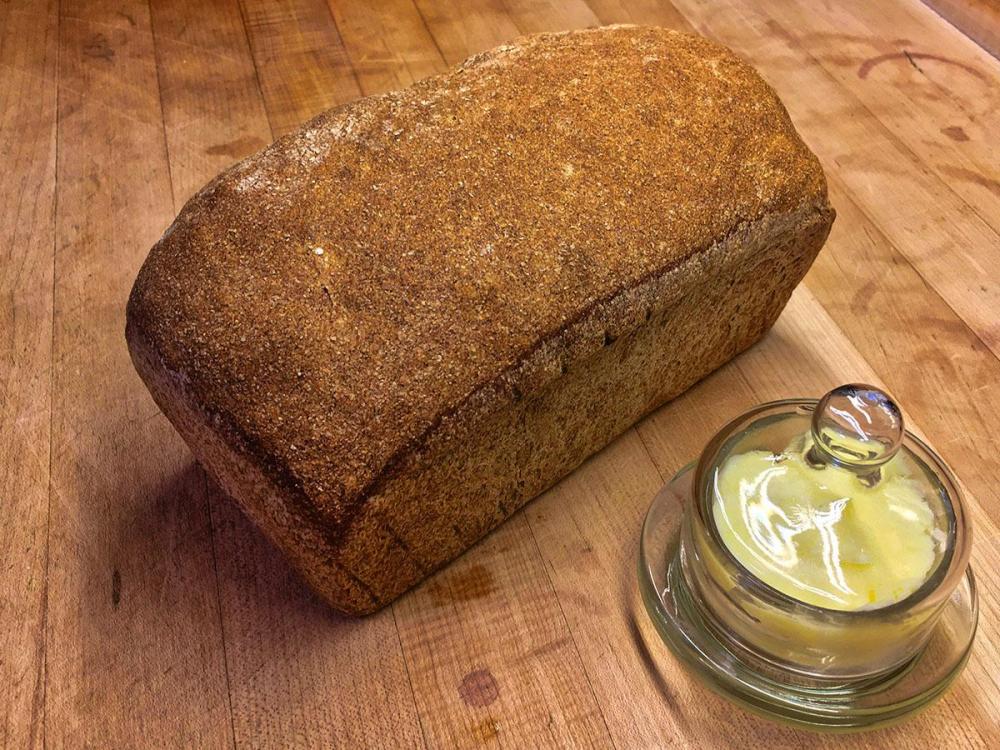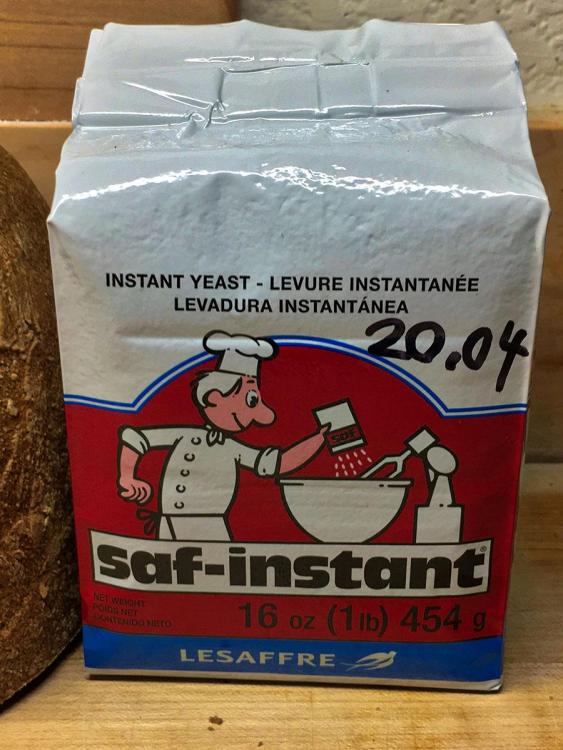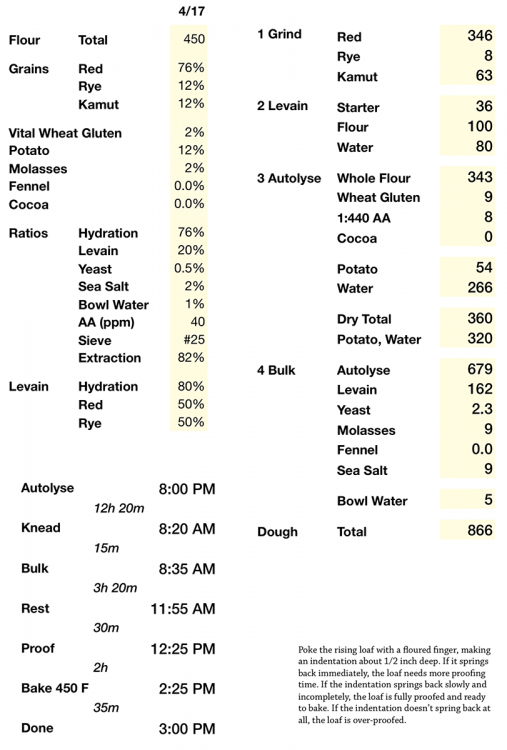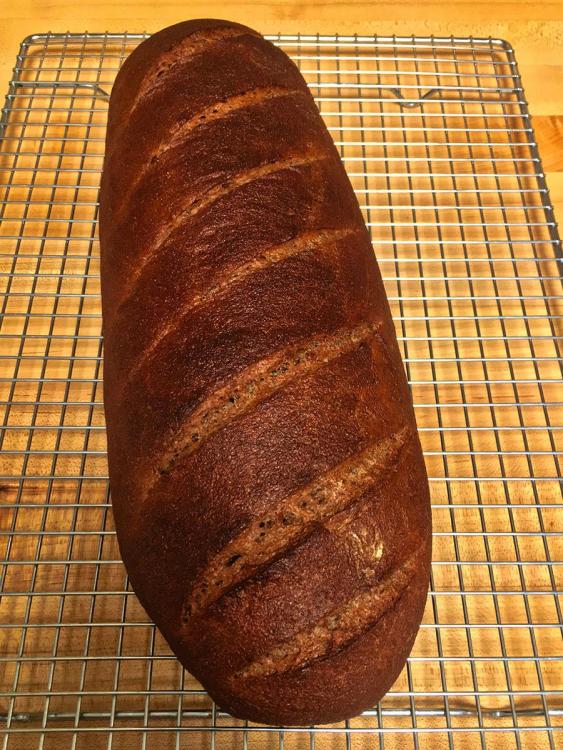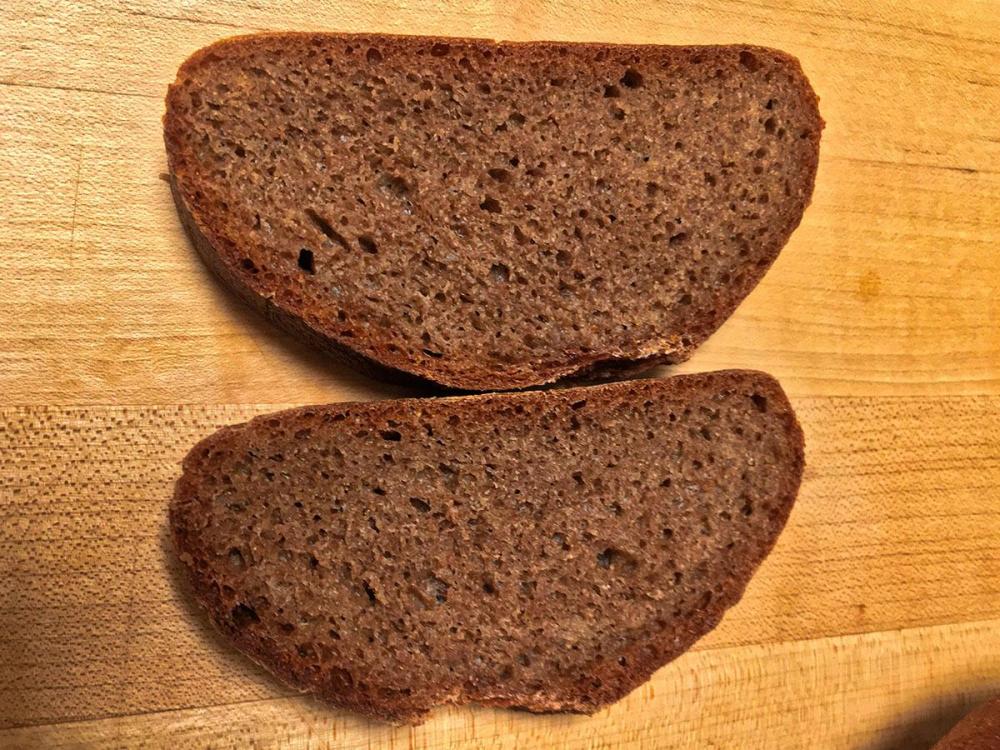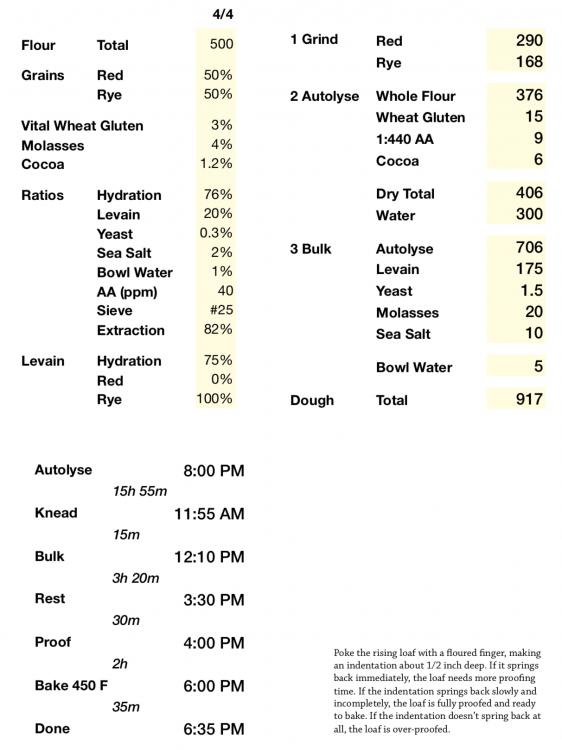-
Posts
1,738 -
Joined
-
Last visited
-
Days Won
53
Content Type
Profiles
Forums
Events
Everything posted by Syzygies
-
Spatters don't generally reach the walls, I keep it clean, and I regularly reach temperatures that Dennis would probably consider ill-advised.
-
I first bought the wrong kind of butcher paper for BBQ: white, coated. One wants pink; the brown pictured on the commercial dispenser is probably also fine. I hung my white roll in the garage for general use. My "cutter" is a pair of shop shears. I measure by paying attention to the landscape as I pull down paper.
-
-
Cast iron rusts. For many years I used an unglazed 16" terra cotta plant saucer from a box store. I'd use it by itself as a heat deflector, lined with heavy duty foil to double as a drip pan. Each one would last a few years then crack, but they don't cost much. Still the inexpensive solution I'd recommend to anyone. I love my "official" double bottom heat deflector, drip pan, but one could buy decades of terra cotta plant saucers for the same money.
-
Mine sits easily on the lower rack, with an ideal margin all around for airflow, and no interference with handles. Which KK do you have? Which drip pan did you order? Are you sure they're matched? Dennis can surely help.
-

Vermicular Cast Iron Induction Cooker
Syzygies replied to PVPAUL's topic in Relevant Product Reviews
I've been using mine one way or another every day since it arrived. Even last night's pasta sauce, that I do versions of for decades in other pots, just to calibrate my understanding of what it can do. The computer programmer in me loves how I can offload work to it, less attended, with none of the limitations of sealing food in a plastic pouch. While ingredients sautéed, I was outside roasting chiles on my Solo Stove Campfire, another tool I love because it's not an attention hog. A Moroccan tagine of lamb, fava beans, artichokes (all fresh from our farmers market) was an interesting exercise in adaptation. First steam roast the vegetables, a classic mode of operation for what Laurie has dubbed our "indoor K". Set aside, sear then cook the lamb and spice mixture, with ample mounds of parsley and cilantro on top. Arranging ingredients in a thoughtful stack as the Moroccans do for clay, works here because the induction delivers more uniform heat. Then add back the vegetables with the preserved lemon to finish. This sequence would allow cooking the vegetables above 185 F (a known sous vide threshold) and the meat below 185 F. We didn't this time, because I ran out of time. I'll experiment with the plainer lamb Tangia to dial this in. We're eyeing the space occupied by our high end Zojirushi rice cooker (though I keep this K close by the cutting board, under our range exhaust fan, for uses like tagine). I'd heard the praise for rice made in a purpose-built clay Kamado-san Double-Lid Donabe Rice Cooker. And I love mine, though rice in it is more work, and simply different, not a compelling reason to give away one's Zojirushi. Following Vermicular's brown rice instructions to the letter using Massa Organics brown rice, we made the best rice I've ever tasted. I've been in correspondence with Vermicular.us. They're thinking about starting a forum like ours. There's so much to figure out, adapting this K to international cooking. -
Burning Love (Elvis Presley)
-

Vermicular Cast Iron Induction Cooker
Syzygies replied to PVPAUL's topic in Relevant Product Reviews
I believe that I understand its purpose better than any English language review I've read. In the 1980's I'd read somewhere (Patricia Wells?) that some French chefs with access to restaurant vacuum packers were "steaming" fish by instead vacuum packing the fish with marinade to cook in a water bath. And Harold McGee's On Food and Cooking: The Science and Lore of the Kitchen was published in 1984, discussing how the boiling point of water is an arbitrary crutch in cooking. Putting two and two together, I looked in various science supply catalogs hoping to set up a sous vide cooking system (without having heard anyone was actually doing this, e.g. for foie gras in France). It was beyond my budget. I was a bit aghast that I hadn't pushed harder, when many years later I saw sous vide cooking emerge. One misses most advances in math or science by simply not pushing hard enough. Plenty of people are smart enough, or much smarter than the people who make breakthroughs. The people who make breakthroughs are pathologically stubborn and don't give up. I'd given up. Agitated, I started playing with the same kind of temperature controller used in the BBQGuru, and modifying soup warmers to bypass their thermostat. Then over time actual equipment designed for this became affordable. Now we own various Joule circulators, with clumsy earlier circulators in the garage or discarded. And as you say, we don't make skyscraper food. Sous vide becomes a standard technique. A step, never the complete process. Sous vide cooking a finished dish is throwing a ball blindfolded, hoping it lands somewhere near your intended target. Fine for a restaurant that gets a thousand tries. Takes all the fun out of cooking at home. One often wants to sear first, often in the same pot, then fiddle, taste, and season as one cooks. Add or remove ingredients on a timetable. For this reason it completely baffled me that slow cookers remained so primitive, weren't stepping up their game. I've met "titans" of weaker industries; they only triumph because anyone with two brain cells to rub together gets out of that industry. They have self-serving explanations for why they're dragging their feet on progress, which ususually comes down to customers already not wanting to pay the $60 they're asking for $4 of Chinese electronics. So I've been watching this market. The Breville | PolyScience the Control Freak costs $1500 and is nowhere near as effective as the Vermicular which encloses its enamel cast iron Dutch oven. I wish that the Vermicular didn't cost $670, but it doesn't cost $1500, and it's not going to cost $60. I bought my most recent Staub Dutch oven on sale, but the Vermicular Dutch oven is fairly priced for what is a top-of-the-market pot. I've also gone fairly deep down the Japanese cooking rabbit hole. My last international trip before quarantine was to Japan. I imported a Katsuobushi bonito shaver. I own many Donabe pots from Toiro Kitchen. There's something austere yet deeply comforting about the Japanese approach to vegetables. Various of the Vermicular cooking modes make most sense in the Japanese tradition from which it springs, though they translate well to other cuisines. My braised cabbage, my first use, is a good illustration. If one had been thinking of something like the Vermicular, wishing one could build one, then it's wonderful they'll build it for you. Simply being told one wants this isn't going to sell many units, and will lead to disappointment. Though it may be advanced, it's also freedom. We were drinking rose in the shade during a hot California evening, when we'd normally be inside cooking. If you found this thread by googling Vermicular, look around. There are many serious cooks here, and they're here because the Komodo Kamado is the best ceramic charcoal cooker made. It's worth every penny. -
My last trip before quarantine was to take a weeklong woodworking intensive with Jeremy Tomlinson at The Urban Woodworker in North Vancouver. I met him at a Lie Nielsen hand tools expo in Oakland, and knew the weeklong would be well worth the trip. I'm not in a hurry, I came out of this deciding to prep and finish (resaw, true) my wood by hand, like our ancestors did. Not that it's warm enough to work outside in California, I'm just waiting to finish other pressing chores. Today I finish reworking our garden irrigation system, to take out some corroding unions and add a flow meter, and inline strainers before each valve. Not my idea, the valves were getting stuck open. I'm good enough at plumbing for "handy" friends to ask for my help, but I enjoy sweating pipes the way one enjoys a prison sentence. Like, not. Wood, and bread, on the other hand, invites and responds to love.
-
Our favorite loaf pan bread yet. Lots of farro available from unrealized past aspirations, and it really works as a guest flour here. And it dawned on me that I can have lots of rows in my history spreadsheet for every possible ingredient combination, yet I can automate only showing the ingredients in use for my recipe printout. Sourdough Whole-Recipe.pdf
-

Vermicular Cast Iron Induction Cooker
Syzygies replied to PVPAUL's topic in Relevant Product Reviews
I went for it. Am I really the first, here? Can't be. After all, like orangutans these be Kamado cousins to us. Vermicular We're pretty thrilled. Much easier to use by playing with the control panel than by trying to understand the directions. Though the imposing hardbound recipe book gives some idea of potential range and technique. Our first try was Lion's Head Meatballs. We get awesome ground pork from a local farmers market. Local cabbage, our house chicken stock, good fino sherry, hand-stirred Zhongba soy sauce (now back back in stock) from Mala Market. A gentle dish that shows its flavors. Rejiggering the recipe for the Vermicular, I first cooked the cabbage on low for an hour, with just a pinch of salt and some lard. Stir a couple of times, otherwise away from the kitchen, I love how unattended this is. One could of course use a low oven, but this is more predicable and in my face when I want it to be. The cabbage browned and melted, with little risk of burning, exploiting the special tight lid design. I then set aside the cabbage to simmer the meatballs in broth. Here I first tried an hour at 180 F. Did you know meatballs could be too tender? We've made this recipe before, conventionally, and perhaps it is tuned for more aggressive heat. Though the flavors were unworldly. I turned it up to 200 F while flipping the meatballs and adding the braised cabbage on top. A lot to learn, the best of sous vide and meddling as one cooks, with the opportunity to brown first in the same pot. I'm thinking Moroccan tagines will shine here. -
I do feel like I've lost my convictions, using a loaf pan, but they're more forgiving and the bread is more useful. We always add a bit of yeast as insurance to sourdough recipes. Laurie buys it by the pound, using it in many other ways. (She also has a separate yeast for sweeter breads.) We got lucky that our health food store had stock today.
-
Yes, sorry, I'd probably design the spreadsheet differently if my primary goal was to show it to others. It would be too complicated for me if I were doing this once. I'm going on a hundred loaves, and I want to home in on new recipes as quickly as possible. To give one example of the dozens of issues that a spreadsheet resolves for me: I can change my sourdough starter from 100% hydration to 50% hydration, then back to 80% hydration, without changing the true hydration of my bread recipes. The spreadsheet adjusts for me. I find it mind-boggling how many recipes out there just ignore the hydration of the starter. The authors have no idea what the true hydration is for their recipes. Mathematicians find it easier to figure out what someone else is doing by learning their goals, then reverse engineering their methods. Only by trying to figure it out by ourselves can we understand what someone else is doing. Here, my goals are these: I'm making bread from potato and 100% home ground grains, using a sourdough levain and an autolyse step. The spreadsheet takes bakers percentages and similar inputs (smaller print in upper left box), and converts them to the grams I need to measure (larger print in upper right box). 1. Grind the grains for this loaf. While I have sourdough starter food made up for many days at a time, I need to grind grains for this loaf. I find that with the current state of my grinder, and the sieve I use, I get a yield of 82%. The spreadsheet computes how much grain to grind, based on this. 2. Feed the starter. There's a minimum I want to feed the starter each time, but when I'm making two loaves using lots of starter, I want to make sure I make enough starter. I'd rather code this and follow directions each time, than try to remember to do this in my head. Of course I did this in my head for years. Having numbers prepared for me, to check off, is easier and more reliable. Even if I only screw up this calculation in my head once every six months, I'd rather not. 3. Autolyse the flour. I cook potatoes in water, top up the water to correct for what boiled off, and add it to my dry ingredients to soak overnight. I love the effect of the potato. Soaking overnight has a big effect, particularly on whole grains. I've tried leaving out this step. I always return to it, even when adapting recipes that don't call for an autolyse. 4. Knead the dough for the bulk rise. The next morning, I assemble and knead everything together. Then bulk, bench, proof, bake as usual. The timetable helps me start early enough to also be able to walk the dog when Laurie gets off work. Grind, feed, autolyse, knead, this is a straightforward and common way to make bread. I need numbers to check off as I work, or else once every six months I leave out the salt. For this style of bread, anyone's recipe would look something like this.
-
We really like this loaf. 100% home ground grains. We cook the potato in the autolyse water, blitz it with an immersion blender, and top up the weight with more water. Mix in a stand mixer. The potato has a really nice effect on texture, and smoothing out the grain flavors. We actually bake 385 F for 35 minutes in the loaf pan, then 10 minutes out of the loaf pan.
-
Bread Loaf Baker Well, if it's European that makes it ok. I don't understand the lid. My portion control isn't good enough to just miss the lid as my dough rises. What am I missing?
-
How did you sprout the rye? My last loaf was also in a loaf pan. It felt like a crisis of principles, but it was in fact liberating to not have to restrict myself to doughs that can support themselves.
-
You are my hero! 60% kamut, 90% hydration? Wow. That's unexplored territory for me.
-
It amazes me how these gun-toting idiots can't identify their true enemies. As far as I can tell, they actually vote for their true enemies. If they ever figured that out, at least we'd come out of this crisis with better gun control.
-
Organic Durum Wheat! Let us know how that turns out, we weren't happy with our source. I had hoped to at least make it our primary wheat for pasta, but I was just name-matching. We like Hard Red best, mixed down with semolina flour. I ordered our Durum Wheat kernels in New York (my work apartment) and flew half of it to California (our home). At JFK security I was selected for testing, perhaps because this looked odd on the X-ray. As an aside, I used to fly a lot, and I'm no stranger to unusual experiences at airport security. After we moved my Mom from Maine to California, we were closing up her house to sell, and I took responsibility for transporting what we hadn't scattered of my Dad's ashes. Now, we're a bit of an odd family, and these ashes had a storied history. My wife and I were on the phone with my Mom when the box came by postal mail, and she brightly said "Oh, your Dad's home!" He had died from dementia, but the proximate cause was thirst once he couldn't swallow. When I next saw the ashes box, it was still unopened, but there was a bottle of spring water on top. I cautiously asked my Mom if there was any significance to this? No, it was an available horizontal surface. Finally, my family gathered to scatter his ashes from Peaks Island, and my Mom asked that we reserve some ashes for her to keep. We lined a ball jar with some red tissue, and I took the still-unopened box down to the cellar, to my Dad's old workbench. Irish Catholic Mom, woodworking hobbyist Dad. Alter, workbench. Made sense to me. My sister came down to see the proceedings, and exclaimed in shock that I was spilling ashes onto the workbench. "So?!" She then got it. My brother now has this workbench. To fly with the ball jar, I took absurd precautions, and it was wrapped in substantial foam. I was the first bag for a new shift at security, and this really looked funny on the X-ray. "What's in the jar?" the agent asked brightly. People in Portland, Maine are friendly. "My Dad." I'm a bit insulated from how people outside my family take this sort of thing. Normally after any concern at airport security, you're no longer allowed to touch the items of interest. Here, I basically had to spend the next ten minutes counseling the guy, and he stood as far back as possible while I moved the jar to its own bin to be X-rayed again. Ok, back to the Durum Wheat kernels. This experience could well have colored my relationship with that variety of wheat. The Durum Wheat kernels flunked the explosives test. If you've never had this happen to you at an airport before, let me tell you, it's a real mood changer. I was no longer allowed to touch my possessions. I was taken to a room, stripped to my skivvies for a body search while they went through my baggage very carefully. This was before I had learned (in fact, how I had learned) that only a complete frickin' moron doesn't have a dedicated pocket in their carryon for their pocket valuables. My wallet, keys, phone, money clip were loose in the gray bin, and they returned everything to me. Except my money clip. When I asked where it was, the lead security officer flat-out told me I was lying. She was pretty smart; I was struck earlier by her remark that organic grain shouldn't flunk a nitrogen test, was I sure this grain was really organic? But she reverted to form. (I want to say something obscene about Mitch McConnell here, as we're all pretty frustrated in the US right now, but I would be digressing.) I insisted on filing a police report. Then the money clip appeared without apology. It had stayed in its bin until the bin made its way through the rotation, and a passenger spotted it as they were about to use the bin. Honest person, they turned it in, I got it back. Then the TSA made me wait for the police agent to arrive; the fact that the report was no longer necessary didn't matter. Two can play power games. One doesn't want to ask me about emergency preparations, on board a dive ship. The computer programmer in me tends to anticipate everything. After a few minutes of my answer, no one would want to dive. So, yes, like my bread spreadsheets I have spreadsheets for my travel schedules, and I have a very active imagination for what could go wrong. Of course I made my flight.
-
This is the fastest I've ever homed in on a bread recipe. I borrowed principles and my spreadsheet from before, to adapt a Suas recipe. Then figured out various additions again consulting Suas, e.g. 3% for vital wheat gluten. So far, very different from our other breads, and we don't know what we'd change. Before this, my starter had always been 100% hydration. It is said that "stiffer" levains need less care. The hydration affects the balance of acids. But the thing about 100% is this: You can slip up measuring either the flour or water first, and the math is simple for what to add of the other. Sometimes the starter needs attention and one is too impaired to give it the attention it deserves. The Suas recipe I started from used a stiff levain, 50% hydration. Mixing it in with hydrated dough is just as messy and awkward as 100% starter, only the other way. Ideally there is no impedance mismatch: One's levain has a similar consistency to one's autolyse. So I decided that moving forward my starter would be 100% rye, 75% hydration. Levain, what levain? My starter is my levain. This is easier. One probably wants to use a stand mixer to knead a dough like this. Any sourdough rye dough is rather sticky. Add vital wheat gluten, molasses, and cocoa, and you've got an all-nature sub-flooring construction adhesive.
-
Ha! There's a problem with my spreadsheet-based incremental development approach to tuning recipes: So far, no matter where I start, I end up with the same standard recipe. I came back from Morocco two summers ago making their thick flat bread, kept tweaking it, and ended up right back where I was before the trip. These days, I'm working on sourdough rye / pumpernickel / mountain bread. I figure if I keep the rye at 50% this won't turn back into my standard recipe. What I do for unusual grains is have a "guest" slot in my standard recipe, 10% of some odd grain I have around. 10% never throws off the results, but we can taste it. 20%, even what's supposed to be another version of hard wheat, and the bread can act funny. At 10%, I do like emmer in the guest slot. As for sourdough ancestry, I'm somewhat of a heretic. I once took home some "California Gold Rush" sourdough starter from the founder of Shenandoah Vineyards (now long retired) and lost it. There's a lot of malarky out there on how one even gets a starter going. The truth is that unless something fairly awful wins fast, the culture is taken over by whatever rides in on one's starter flour. When one gets starter from someone, that culture is exactly like the aliens that shepherded life on this planet billions of years ago: It keeps the peace and watches over the nascent local culture until it can get established, then disappears without a trace. One might just as well use a bit of yeast and save lots of trouble. But wouldn't the yeast take over? If one bakes regularly, one's kitchen is permeated with yeast, like a French vineyard that ferments using whatever comes in on the grapes themselves. Yeast will always be a component of one's sourdough. The other components will coexist just fine. For other fermentation processes such as the hot sauce I make, I don't trust what's on the chiles. Of course, we have supply chains we don't understand; perhaps garden-grown chiles would be different. But there's a spectacular local pickle shop that relies only on the natural produce to get fermentation going; I love their products but I've reached the uncomfortable realization that they don't keep. Huh. I did lose my starter last year sometime, forgetting it a week too long in the fridge, and I tested my theories: Just add a half teaspoon of yeast to a flour/water mixture, and feed it each day as if it is starter. One actually doesn't need to wait more than a day to make bread with this culture, it just becomes more sourdough-like with time. That's exactly what happened with mine. On my recent Giusto's grain run, through miscommunication we ended up with a 50 lb sack of rye berries rather that 25 lbs. I've been using straight freshly ground rye to feed our starter. Wow. It adapted instantly. You could probably just stare cross-eyed at a straight rye starter mixture, and have it take off like gangbusters. Though after reading about ergot (a toxin common in the Middle Ages, where one believes one is hallucinating that one's limbs are falling off, except they actually are falling off), I'm happy having some yeast supervise the starter.
-
While home in California for the year on academic sabbatical (I'm a math prof), I was hoping to take a weeklong bread intensive at the San Francisco Baking Institute. Actually, it's their second week that interests me (Artisan II: Baking Sourdough, Levain, and Wild Yeast) though I'm not sure about the time commitment. These classes may still happen, though everything is on hold because of the virus. It was through the book by Michel Suas, associated with SFBI, that I first understood "green" (not-aged freshly ground) flour, and the ascorbic acid fix: Mix ascorbic acid 1:20 with white flour, very thoroughly. Then mix that 1:20 with white flour for a 1:440 blend. One can measure this in grams to add, say, 40 parts per million ascorbic acid to one's dough. This is easy after the initial investment in finding and mixing ascorbic acid, and it did solve this problem for me. I've instead started to work through this book: Advanced Bread & Pastry by Michel Suas It was a Google Books excerpt that alerted me to "green" flour. I since bought the book from Amazon UK. It was incompetently packed, being heavy, and arrived very damaged. Return shipping was prohibitive, so they let me keep the copy (it's now in New York) and sent another. Equally stupidly packed, but survived somewhat better. Not the copy you'd choose from the stack in a brick and mortar store, but usable. I'd trust SFBI to do a better job of shipping, as it's their book. We're going through a time with a pretty odd relationship to science and expertise. Global warming or pandemic, it may be our downfall. Bread is a relatively light topic, but the mere existence of this book illustrates a vast chasm between what a French-trained professional with decades of experience understands about bread, and what "blind leading the blind" lay writers for amateur home bakers understand. I felt that I was making progress when I gave up Peter Reinhart for Lent. I nevertheless found reading Chad Robertson's Tartine Bread a breakthrough experience (even though we can actually go buy Tartine bread, and we find it unnecessarily scorched in its signature style). But these guys are all guessing, even as they're learning fast by talking to others. There's a tremendous amount that one can learn from attentive experiment, it's not a surprise that the most strikingly original bakers of our day are self-taught. But then one wants to solve a problem, like the problem of "green" flour. As a research mathematician, this is a quandary that I recognize. Work alone, be strikingly original, but give up on thousands of years of supporting insights and intellectual infrastructure. Work too hard to instead master this history of ideas, get sucked into conventional thinking and sacrifice all originality. Each researcher's identity ties to how they resolve striking this balance. Oddly, I could not learn how to pick a lock in my twenties, but I sailed through an evening lock picking workshop recently. One's mind slows down as one ages, but just as Tai chi can teach one to better understand one's body, there are net benefits to better understanding one's mind. When I teach others how to become researchers, this is what I teach. In lock picking in particular, one is trying many possibilities in rapid succession. In problem solving too, there can be critical phases where one needs to be able to rotate through hundreds of possibilities in rapid succession. The researcher who has spent decades studying other peoples' work can generate these hundreds of possibilities in their head, from experience. The lone original wolf, no matter how brilliant, doesn't stand a chance at keeping up. Sometimes they'll instead try one thing that is so out of the norm that experienced researchers would have never considered it, and be lucky, but generally being a lone wolf puts one at a disadvantage. When I want a lazy way to expose myself to hundreds of possibilities for how my bread might improve, I flip through the Suas book. At farmers markets I've met my share of bread bakers who freshly grind but don't understand "green" flour. The key for a professional operation is reproducibility. They're making the same breads day after day. Once they've found protocols that work, they're good. I keep trying new procedures and recipes, so I'm relying on ascorbic acid to get that variable out of my way. I really don't know what you might have discovered, but it makes sense. The balance of acids varies with the stiffness of the levain, affecting the chemistry of gluten formation. Tonight's sourdough rye put me way outside my comfort zone, because the levain protocol was so different. When I flip again through Suas, I haven't even tried most of his ideas that could be relevant to making a rye sourdough come out. I'll play with them one or two at a time, so I have some hope of relating these ideas to experience. So, hopefully you'll be able to replicate this success without ascorbic acid. If not, ascorbic acid is actually quite easy.



